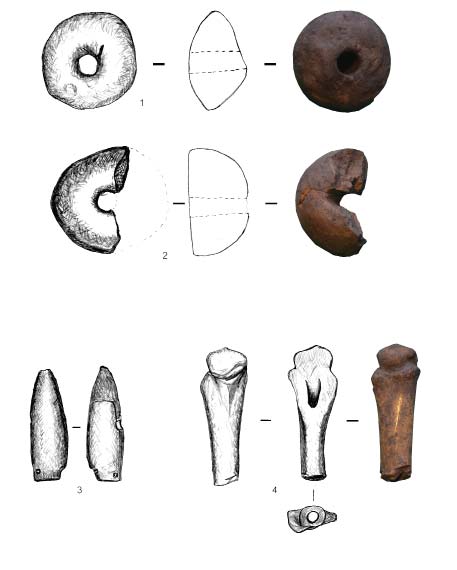NEW MATERIALS FROM ZININO-1 ANCIENT VILLAGE
DOI:
https://doi.org/10.24852/2587-6112.2021.2.250.260Keywords:
archaeology, Early Iron Age, Kara-Abyz culture, Ubalar type, Southern Cis-UralsAbstract
Zinino-1 ancient village is a seasonal site of the Ubalar cultural type of the Kara-Abyz archaeological culture. The paper discusses the results of a study of ceramic and zooarchaeological material from the excavations carried out at the site. The purpose of the study was to assess the degree of infl uence of the Ubalar population on the economic structure of the carriers of the Kara-Abyz culture in general. The collection of ceramic material vividly illustrates the “symbiosis” of the population of the Southern Urals at the turn of the historic periods. An analysis of impurities to the molding mass of the vessels made it possible to establish the predominance of
ceramics of the Ubalar type, which substantiates the cultural attribution of the ancient village. Ubalar ceramics is distinguished by the dense texture of the dough and the high content of sand therein. The individual fi nds include four fragments of grating slabs, but their purpose remains unclear. Presumably, they were not used in food preparation. The zooarchaeological material is scarce. The concentration of bones in the cultural layer is low; only in the fi rst horizon contained animal remains in all its sections. Despite this, animal remains have been identifi ed at the site, originating from fi ve domestic and two wild species. Cattle is predominant in terms of the number of bones. A recalculation of the number of bones for the volume of meat products gives ground to say that the basis of the meat ration of the village’s inhabitants was beef and horse meat. In general, the reviewed material does not give reason to say that the arrival of the Ubalar population had a signifi cant infl uence the economic structure of the Kara-Abyz tribes.
References
Antipina, E. E. 2008. In Buzhilova, A. P. (ed.). OPUS: Mezhdistsiplinarnye issledovaniia v arkheologii (OPUS: Interdisciplinary Investigation in Archaeology) 6. Moscow: Institute of Archaeology RAS (6), 67–85 (in Russian).
Babin, I. M. 2015. Nauchnyi otchet o provedenii arkheologicheskoi razvedki v basseine r. Yurmash i na vodorazdelnoi territorii r. Belaia, r. Yurmash v Iglinskom raione Respublike Bashkortostan v 2015 godu po Otkrytomu listu №1372 ot 18.08.2015 g. (Scientifi c Report on the Archaeological Exploration in the Basin of the Yurmash River and the Watershed Area of the Belaya River, Yurmash River in the Iglinsky District of the Republic of Bashkortostan in 2015 on the Basis of the Open Sheet No. 1372 dated August 18, 2015). Archive of the Laboratory of Archaeological Source Study and Historiography of the Bashkir State Pedagogical University named after M. Akmullah) (in Russian).
Bakhshiev, I. I., Savel’ev, N. S. 2013. In Ufi mskii arkheologicheskii vestnik (Ufa Archaeological Herald) (13), 104–115 (in Russian).
Vorobeva, S. L. 2017. In Tairov, A. D. (ed.). Etnicheskie vzaimodeistviia na Iuzhnom Urale (Ethnic Interactions in Southern Ural) VII. Chelyabinsk: State Museum of the South Ural History, 31–37. (in Russian).
Grichuk, V. P., Zaklinskaya, E. D. 1948. Analiz iskopaemykh pyl'tsy i spor i ego primenenie v paleogeografi i (Analysis of Fossil Pollen and Spores and its Application in Paleogeography). Moscow: “Geografgiz” Publ. (in Russian).
Kurmanov, R. G., Ovsyannikov, V. V., Savel’ev, N. S., Galeev, R. I. 2019. In Geologicheskii vestnik (Geological Bulletin) (1), 35–44 (in Russian).
Ovsyanikov, V. V., Kayumov, I. Kh., Babin, I. M 2015. In Ufi mskii arkheologicheskii vestnik (Ufa Archaeological Herald) (15), 85–110 (in Russian).
Ovsyanikov, V. V., Kayumov, I. Kh., Babin, I. M 2015. In Ufi mskii arkheologicheskii vestnik (Ufa Archaeological Herald) (15), 85–110 (in Russian).
Ovsyanikov, V. V. 2018. In Vybornov, A. A. (ed.). XXI Ural'skoe arkheologicheskoe soveshchanie (21th Urals Archaeological Congress)). Samara: “Samara State University of Social Sciences and Education”, “Porto-Print” Publ., 232–234 (in Russian).
Ovsyannikov, V. V., Savel’ev, N. S. 2019. In Arkheologiia Evraziiskikh stepei (Archaeology of Eurasian Steppes) 2, 201–226 (in Russian).
Protsenko, A. S., Sataev, R. M. 2016. In Vestnik Tomskogo Gosudarstvennogo universiteta. Istoriia (Bulletin of the Tomsk State University: History) 44 (6), 125–133 (in Russian).
Protsenko, A. S., Kurmanov, R. G. 2019. In Vestnik Akademii nauk Respubliki Bashkortostan (The Herald of the ASRB). Vol. 33. 96 (4), 62–71 (in Russian).
Savel’ev, N. S. 2010. In Gerasimova, M. M., Malashev, V. Yu., Moshkova, M. G. (eds.). Arkheologiia i paleoantropologiia evraziiskikh stepei i sopredel’nykh territorii (Archaeology and Paleoanthropology of Eurasian Steppes and Adjacent Territories). Series: Materialy i issledovaniia po arkheologii Rossii (Materials and Studies in the Russian Archaeology) 13. Moscow: “Taus” Publ., 295–318 (in Russian).
Savel’ev, N. S. 2011. In Rossiiskaia Arkheologiia (Russian Archaeology) (2), 56−66 (in Russian).
Savel’ev, N. S. 2017. In Ufi mskii arkheologicheskii vestnik (Ufa Archaeological Herald) (17), 18–38 (in Russian).

Downloads
Published
How to Cite
Issue
Section
License
Copyright (c) 2021 A.S. Protsenko, R.M. Sataev

This work is licensed under a Creative Commons Attribution-NonCommercial 4.0 International License.







